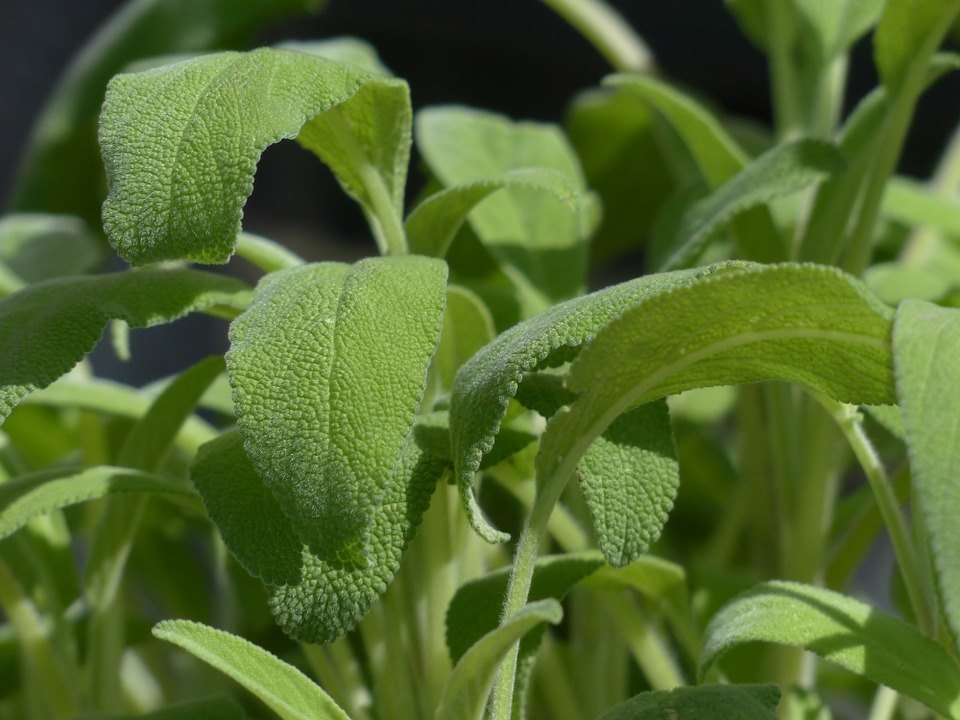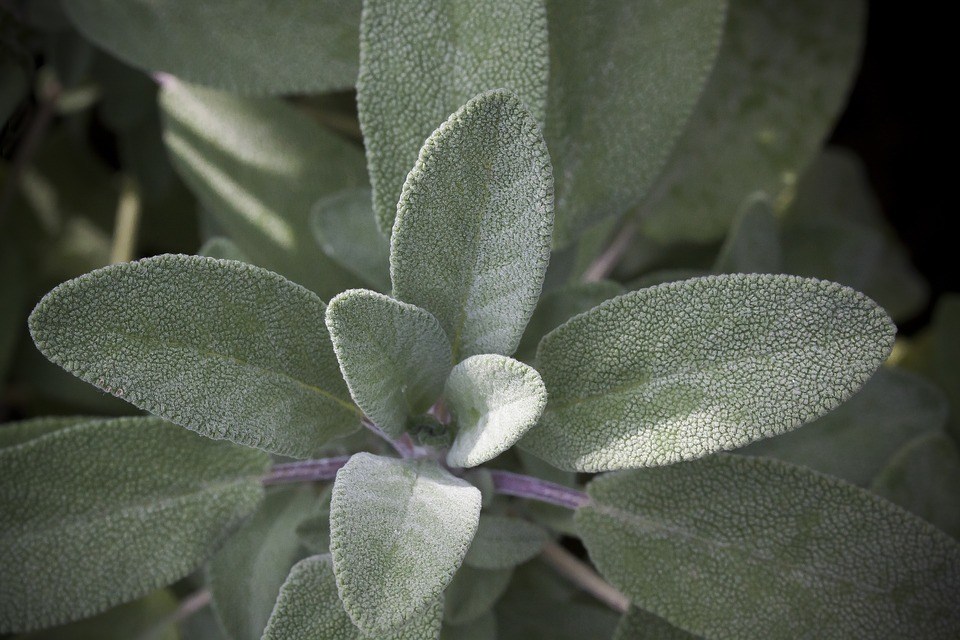Sage is good for more than just turkey stuffing at Thanksgiving or Christmas. It’s used more extensively outside the United States; for instance, in England in Sage Derby cheese, in Italy in saltimbocca (a veal dish) and in sausages in Germany. Garden sage (Salvia officinalis) is native to the Mediterranean, and it is part of the evergreen mint family, similar to rosemary, basil and oregano. Growing the sage plant takes a bit of work, but it’s worth it to have this fragrant, versatile herb fresh when you want it.
Overview of Garden Sage

Sage is a robust plant that can handle cooler weather. As it grows, it becomes a bush with a circular shape. Its stems are tough, and its leaves are thick. The leaves used for cooking have a hazy green color and veined indents. Sage is known for its strong scent, which is a cross between citrus and pine. The flavor of this herb is similar to rosemary but earthier and slightly bitter. Cooking can tone down its strong flavor.
Benefits of Growing Sage
This herb is delicious in many different foods. Meat eaters, vegetarians, vegans and others on special diets can enjoy it because it goes well with meat, vegetables, legumes and grains. You can sprinkle some in a grilled cheese sandwich, sauté it with mushrooms or add it to melted butter for fish and pasta dishes. You can even use it in bourbon cocktails. You can pair it with many different herbs, including members of the same family, such as rosemary and thyme.
Fresh sage is more flavorful than the dried herb you get in a bottle at the grocery store. Because it’s a hardy, perennial plant, you’ll be able to use it fresh into late fall. When planted properly, this herb can produce many leaves, so gardeners only need one plant to give them enough sage throughout the growing season.
How to Grow the Sage Plant
This herb demands certain conditions to make it grow well. Despite this, it isn’t particularly difficult to grow if you go about it correctly. Here are suggestions for planting, maintaining and harvesting sage.
Planting Sage

Gardening experts don’t recommend trying to plant this herb from seeds because they take some time to grow. If a garden center near you has starter sage plants, then you might want to save yourself some trouble by buying one and transplanting it in your garden. Otherwise, it’s best to use cuttings from a mature sage plant or the layering method.
Cuttings

Cuttings are simply stems with leaves that can get your sage plant going. Here’s how to use them:
- leaf
- leaf
- leaf
- leaf
- leaf
- leaf
- leaf
- leaf
- leaf
- leaf
Layering

This method takes advantage of this herb’s ability to form roots from a stem that’s still attached to the plant. This is a great method for adding another sage plant to your garden or replacing an old one that isn’t producing tasty leaves.
- leaf
- leaf
- leaf
- leaf
This herb does well when planted alongside cabbage, carrots, tomatoes or strawberries. As long as you give it room, it will also flourish near your flowerbeds. Since the sage plant produces beautiful purple blossoms, it attracts bees and can benefit other flowers. Sage can get bushy, so keep multiple plants 24 to 36 inches away from other plants.
Wait until the ground temperature is about 65 degrees to put new plants into the soil. This is typically around February in warmer states (Zone 8, 9 and 10) and April in Zone 5, 6 and 7. In Zone 3 and 4, the ground doesn’t reach this temperature until May.
Maintaining the Sage Plant
Sage needs to receive full sunlight, so make sure to find a suitable place for it in your garden. There’s no need to water this herb excessively, and doing so will cause mildew, which will look like a light gray powder on the surface of the leaves or stems. Periodically check the soil, and only give your sage plants a good watering when it’s bone dry.
Use fertilizer sparingly because too much of it can affect the flavor of your sage leaves. Try to keep soil pH between 6.0 and 7.0. Monitor it with a soil pH meter. If it’s significantly below 6.0, use garden lime to bring it up. Use soil acidifier if the pH level is much above 7.0.
As your sage plant starts to get bushy, carefully remove leafy stems to thin it out. The best time to do this is in the morning hours when the stems are dry but not too stiff. It’s a good idea to occasionally clear the bottom of the plant so that there’s a space of a couple of inches between the ground and the bottom stems. Check for crowded stems at the base of the plant, and remove some to prevent the growth of fungus. Also look for dead branches, and cut them as soon as you see them. This periodic pruning encourages new shoots.
Beware of caterpillars, as they can eat your sage leaves in a very short period of time. When you see one, pick it off and put it in a container of water mixed with dishwashing liquid before disposing of it. Slugs can also drill holes in the leaves. Sprinkle small pebbles, coffee grounds or coarse sand around your plant to keep them away. If you see any kind of insect infestation, you can spray the tops and bottoms of the leaves with insect-killing soap. Just be aware that the soap will also kill beneficial insects, so only do this if you’re seeing significant yellowing or wilting of the leaves.
Harvesting Sage

Young sage plants are sensitive to over-harvesting, so avoid stripping them of too many leaves in the first year. It’s best to use a pruning tool to cut the stems, although you can also carefully remove a leaf from its base for smaller harvests. Look for leaves that have a healthy gray-green color and soft coating. They should be firm but not hard to the touch.
The best time to harvest sage leaves is in the late evening or early morning. If you can get to the sage plants before they flower and when the leaves are at least 1.5 inches long, then you’ll be getting the best flavor.
Some experts say you should replace sage plants after 4 or 5 years because the leaves lose their flavor, but gardeners have found that pruning sage bushes in early spring to reduce their clutter maintains the flavor of the leaves. It also helps to do a more thorough pruning twice during the growing season, but take care not to remove more than half of the stems each time you do this. If your sage plant has weak leaf production or flavor, it’s time to add it to your compost bin and plant a new one in its place.
During intense pruning, you’ll likely find yourself with an abundance of sage leaves. Preserve them to use throughout the winter with these steps:
- leaf
- leaf
- leaf
- leaf
- leaf
Sage is a plant that anyone can grow with a little care. It’s a versatile herb that suits multiple eaters and has a long growing season. If you love the idea of going out to your garden to pick fresh sage leaves for your vegetable, meat or grain dishes, then invest some effort in planting a sage bush. You and your family will reap the rewards for a long time to come.